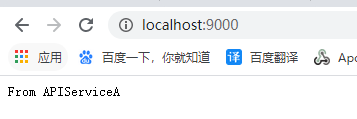Ocelot可以在每个路由的可用下游服务中实现负载均衡,这使我们更有效地选择下游服务来处理请求。负载均衡类型:
LeastConnection:根据服务正在处理请求量的情况来决定哪个服务来处理新请求,即将新请求发送到具有最少现有请求的服务去处理。算法状态没有分布在Ocelot集群中。
RoundRobin:遍历可用服务并发送请求。算法状态没有分布在Ocelot集群中。
NoLoadBalancer:从配置或服务发现中获取第一个可用服务来处理新请求。
CookieStickySessions:通过使用Cookie,确保特定的请求能够被分配到特定的服务上进行处理。
在Ocelot负载均衡项目示例中,通过网关项目的路由LoadBalancerOptions选项可以配置负载均衡类型:
{ "Routes": [ { //下游路由服务地址 "DownstreamPathTemplate": "/api/values", //下游服务地址访问协议类型http或者https "DownstreamScheme": "http", //下游服务的主机和端口 "DownstreamHostAndPorts": [ { "Host": "localhost", "Port": 9001 }, { "Host": "localhost", "Port": 9002 } ], //上游服务地址,即下游服务真实访问地址 "UpstreamPathTemplate": "https://www.jb51.net/", //负载均衡类型:轮询 "LoadBalancerOptions": { "Type": "RoundRobin" }, //上游服务HTTP请求方式,例如Get、Post "UpstreamHttpMethod": [ "Get" ] } ] }
新请求通过上游访问下游服务的时候,Ocelot会根据LoadBalancerOptions负载均衡选项类型来分发到具体下游服务。
2.服务发现
下面展示如何使用服务发现来设置路由:
{ "DownstreamPathTemplate": "/api/posts/{postId}", "DownstreamScheme": "https", "UpstreamPathTemplate": "/posts/{postId}", "UpstreamHttpMethod": [ "Put" ], "ServiceName": "product", "LoadBalancerOptions": { "Type": "LeastConnection" } }
设置此选项后,Ocelot将从服务发现提供程序中查找下游主机和端口,并在所有可用服务中进行负载平衡请求。如果您从服务发现提供者(领事)中添加和删除服务,Ocelot会停止调用已删除的服务,并开始调用已添加的服务。后续学习服务发现这块知识点时候会重新再讲解。
3.项目演示
3.1APIGateway项目
该项目通过LoadBalancerOptions配置选项定义服务负载均衡请求机制,事例项目使用的负载均衡类型是RoundRobin,在Program添加Ocelot支持代码如下:
public static IWebHostBuilder CreateWebHostBuilder(string[] args) => WebHost.CreateDefaultBuilder(args) //.UseStartup<Startup>() .UseUrls("http://*:9000") .ConfigureAppConfiguration((hostingContext, config) => { config.SetBasePath(hostingContext.HostingEnvironment.ContentRootPath) //添加Ocelot配置文件 .AddJsonFile("configuration.json") .AddEnvironmentVariables(); }) .ConfigureServices(s => { //添加Ocelot服务; s.AddOcelot(); }) .Configure(a => { //使用Ocelot a.UseOcelot().Wait(); });
3.2APIServicesA和APIServicesB下游服务项目
APIServicesA和APIServicesB项目分别新建两个GET请求方法,代码分别如下:
//APIServicesA [Route("api/[controller]")] public class ValuesController : Controller { // GET api/values [HttpGet] public string Get() { return "From APIServiceA"; } } //APIServicesB [Route("api/[controller]")] public class ValuesController : Controller { // GET api/values [HttpGet] public string Get() { return "From APIServiceB"; } }
通过dotnet run命令启动APIGateway项目(网关层)
dotnet run --project APIGateway项目路径\APIGateway.csproj

通过dotnet run命令启动APIServicesA项目
dotnet run --project APIGateway项目路径\APIGateway.csproj

通过dotnet run命令启动APIServicesB项目
dotnet run --project APIServicesB项目路径\APIServicesB.csproj

通过浏览器查看轮询分发给下游服务返回的结果:


负载均衡轮询分发下游服务成功。
4.自定义负载均衡
Ocelot支持自定义负载均衡的方法。自定义负载均衡的类需要继承ILoadBalancer接口类,下面我们定义一个简单的负载均衡循环输出下游服务的示例:
